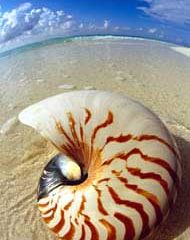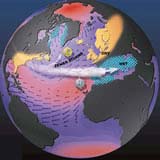
American Geophysical Society Meeting, San Francisco, December 2001
Pressure system secrets could help long range forecasts.
The rise in levels of greenhouse gases has halted an oscillation of air pressures over the Arctic, bringing warmer, wetter winters to Northern Europe, Siberia and Alaska. The shift could get worse with increasing CO2 emissions, delegates heard this week at the American Geophysical Union meeting in San Francisco, California.
The trend is unlikel
In 1998, Paul F. Hoffman and Daniel P. Schrag at Harvard University put forth a chilling description of earth’s climate some 650 million years ago. Their theory, dubbed snowball earth, held that between 750 million and 580 million years ago, ice repeatedly enveloped our planet, coating the seas from pole to pole and killing off early life almost completely. During the past few years, the idea has stirred up a great deal of debate. And new data published in the December issue of Geology only furt

Water trapped for millions of years gives a glimpse of oceans’ turbulent past.
Drops of sea water entombed within salt crystals millions of years ago are giving researchers a glimpse of ancient oceans. The water, trapped during evaporation, reveals that the seas have seen large chemical changes during their history.
“The consensus had been that sea-water chemistry hadn’t changed that much over the past 600 million years,” says geochemist Juske Horita of Oak Ridge National La

With a weather monitoring network a new model could predict coastal floods in Bangladesh. A new model should help forecast the massive floods to which the northern coast of Bangladesh is prone 1 . In principle, the model can predict the heights and arrival times of the huge waves that cyclones cause, and so could improve the planning of sea defences. The effectiveness of the model will depend on the availability of accurate, timely and detailed meteorological data, ca

Ozone miniholes over the North Atlantic follow the unsteady pulse of climate fluctuations.
Recurring fluctuations in the North Atlantic climate are punching miniholes in the ozone layer, exposing Scandinavia and northern Europe to higher levels of ultraviolet radiation than normal, say two climatologists.
Seesawing air pressure over Greenland and the subtropical north Atlantic Ocean stirs the atmosphere and wafts ozone-depleted air towards populated high-latitude regions in

Mathematician Ian Stewart talks to Nature Science Update about snowflakes, sticklebacks and a new kind of science.
Ian Stewart was turned on to mathematics at the age of seven. A broken collarbone freed him from an uninspiring teacher allowing his mother to ignite his interest in numbers while he was laid up at home.
His writing career began with a series of how-to manuals for now-defunct early 1980s microcomputers. It has since broadened into popular science and science fi